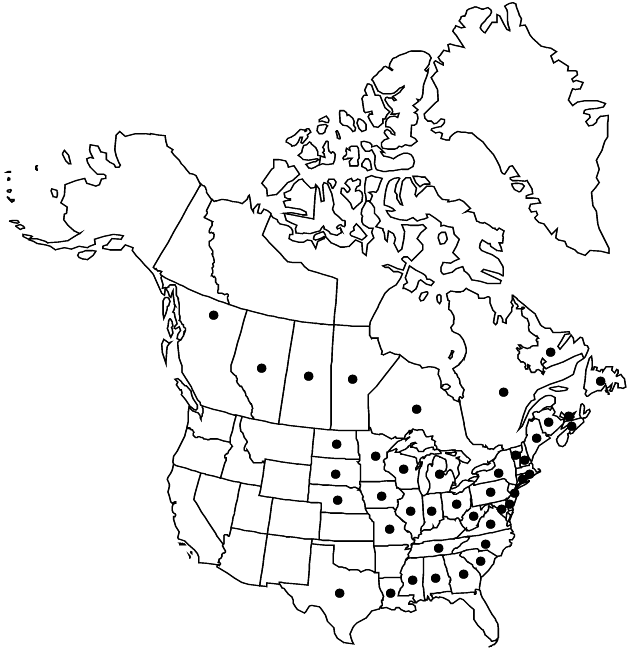Symphyotrichum puniceum
Taxon 31: 359. 1982.
Perennials (7–) 100–250 (–300) cm, cespitose; thickly short-rhizomatous or with stout, branched caudices, sometimes long-rhizomatous. Stems 1–5+, erect (straight to distally flexuous, stout 5–11 mm diam., usually reddish purple), usually densely to sparsely hirsute or hispid, glabrescent, often proximally glabrate, sometimes glabrate. Leaves (dark green, not crowded) thin, margins remotely serrate to sometimes entire, scabrous, apices acute or acuminate to subcaudate, mucronate, abaxial faces glabrate, ± densely pilose along midveins, adaxial glabrate to scabrous; basal withering by flowering, subpetiolate to petiolate (petioles ± winged, bases dilated, sheathing), blades spatulate to oblanceolate or lanceolate, 30–10+ × 3–20+ mm, bases attenuate to cuneate, margins remotely crenate-serrate to denticulate or entire, apices acute or acuminate to rounded; proximal cauline withering by flowering, petiolate to subpetiolate (petioles widely winged, bases auriculate, clasping), blades lanceolate or oblanceolate to oblong, elliptic or elliptic-oblong, (55–) 70–200 (–220) × 10–40 mm, usually progressively lengthened to mid, bases ± attenuate to cuneate or auriculate and clasping; distal sessile, blades oblanceolate or lanceolate to oblong or elliptic-oblong (sometimes nearly panduriform), 8–160 × 1–40 mm, progressively reduced distally, strongly so and linear in arrays, bases ± strongly auriculate, clasping, margins subentire or entire. Heads in open, paniculiform (often corymbiform-looking) arrays, branches widely spreading to ascending, sparsely to moderately leafy with ± large leaves. Peduncles 0.2–3+ cm, ± hispid or hirsute to villous, bracts 0–3, lanceolate or linear-lanceolate to linear, distal often subtending heads. Involucres campanulate, (6–) 8–12 (–15) mm. Phyllaries in 4–6 series, oblanceolate-spatulate to linear, subequal, bases indurate 1/5–1/2, margins not scarious (outer) to narrowly scarious, erose, hyaline, sparsely ciliolate, green zones linear-lanceolate, outer sometimes ± foliaceous, to linear (inner), apices ± spreading at tip when foliaceous, long-acuminate to caudate, mucronate to apiculate, sometimes purplish tinged, faces glabrous or ± hispid. Ray-florets 20–50 (–60); corollas usually pale to dark blue, lavender or purple, seldom white or pink, laminae (7–) 12–18 (–21) × (0.9–) 1.4–1.8 mm. Disc-florets 30–50 (–90); corollas yellow or cream becoming pink or purple, (4.1–) 5–6.5 mm, tubes shorter than cylindro-funnelform limbs, lobes triangular, 0.4–1.1 mm. Cypselae purple or brown (nerves stramineous), oblanceoloid, ± falcate, compressed, (2–) 2.5–3.5 (–4) mm, 3–4-nerved (nerves prominent), faces glabrous or sparsely strigillose; pappi white, 3.8–6 mm.
Distribution

Alta., B.C., Man., N.B., N.S., Ont., P.E.I., Que., Sask., Ala., Conn., Del., Ga., Ill., Ind., Iowa, La., Maine, Md., Mich., Minn., Miss., Mo., N.C., N.Dak., N.H., N.J., N.Y., Nebr., Ohio, Pa., R.I., S.C., S.Dak., Tenn., Tex., Va., Vt., W.Va., Wis.
Discussion
Varieties 2 (2 in the flora).
Symphyotrichum puniceum is one of the widest ranging species in the genus, growing from the edges of the prairies to the Atlantic coast, and from the Gulf coast of Texas to southern Ungava Bay (northern Quebec).
Several taxa have been recognized within this variable species. Here, we segregate Symphyotrichum firmum as a distinct entity. The tall, pink-rayed S. elliottii of the outer coastal plains is also distinctive, despite reports of hybrids with S. puniceum var. puniceum where their ranges overlap (see G. L. Nesom 1997b). A recently described member of the complex, S. rhiannon, is an ultramafic endemic from North Carolina. Here, within S. puniceum, we recognize two varieties, the variable and widespread var. puniceum, and var. scabricaule from the inner Gulf coastal plains, following Nesom, who also offered a useful summary of the infraspecific taxonomy of the species.
Selected References
Key
| 1 | Stems sparsely to ± densely hirsute, glabrescent, sometimes glabrate proximally; abaxial leaf faces paler than adaxial, with a dark, distinct reticulum, adaxial without impressed main veins; array leaves usually equal to mid cauline | Symphyotrichum puniceum var. puniceum |
| 1 | Stems densely and uniformly hirsute; abaxial and adaxial leaf faces ±concolorous, without dark, distinct reticulum, adaxial with distinctly impressed main veins; array leaves reduced in size relative to mid cauline | Symphyotrichum puniceum var. scabricaule |
No values specified.No values specified.